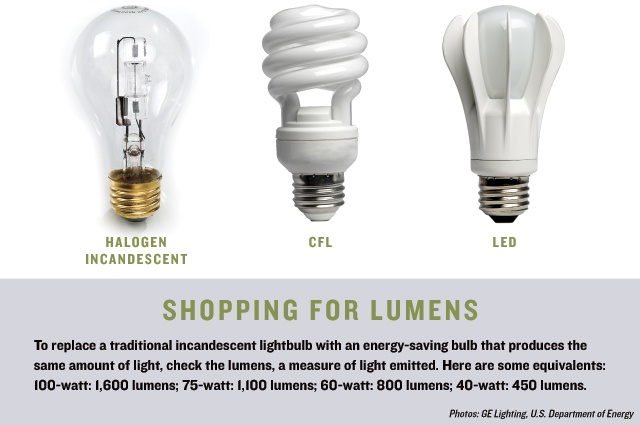Shoppers have to rethink the way they pick out lightbulbs.
Starting this year, the most common lightbulbs that Americans use are required to be 25 percent more efficient under standards set by Congress in 2007 [see update on left]. That means retailers are stocking their shelves with a selection of energy-efficient—and perhaps unfamiliar—alternatives. And new terminology is appearing on the packaging: The word “lumens” describes the brightness of a lightbulb, and the word “watts” describes how much electricity it consumes.
Under the Energy Independence and Security Act, most lightbulbs must use less electricity while producing the same amount of light that consumers are used to getting. The lighting standards, which are being phased in from 2012 to 2014, do not ban incandescent or any specific bulb type. Certain specialty bulbs are exempt from the new regulations.
Traditional 100-watt incandescent lightbulbs, which produce about 1,600 lumens, do not meet the efficiency standards. Traditional incandescent bulbs lose up to 90 percent of their energy as heat. In their place, consumers will find choices—such as newer incandescent bulbs—that use 72 watts or less to provide a comparable amount of light.
After stores sell out of 100-watt incandescent lightbulbs, they won’t be restocked. Similar standards will phase out traditional 75-watt incandescent bulbs as of 2013 and traditional 40- and 60-watt incandescent bulbs as of 2014.
To help consumers understand what they’re buying, the Federal Trade Commission is requiring lightbulb packaging to have lighting facts labels—much like nutritional information labels on food. The lighting facts list a bulb’s lumens, estimated usage cost per year and the color of light it produces. While the variety of lightbulbs and terminology might seem daunting at first, the new labels are meant to help shoppers buy bulbs that suit their needs and save them money on their electric bills.
The U.S. Department of Energy (DOE) estimates that replacing 15 traditional incandescent bulbs in a home with energy-efficient alternatives could save consumers about $50 a year. Although energy-efficient bulbs are typically more expensive, the energy savings over the lifetime of the bulb often makes up for the initial cost. And the newer bulbs typically last significantly longer, bringing more savings, according to the DOE.
Three main bulbs have entered the spotlight as energy-efficient replacements: halogen incandescent bulbs, compact fluorescent lightbulbs (CFLs) and light-emitting diodes (LEDs).
——————–
Suzanne Haberman, staff writer
Visit www.energysavers.gov for more information.


